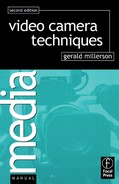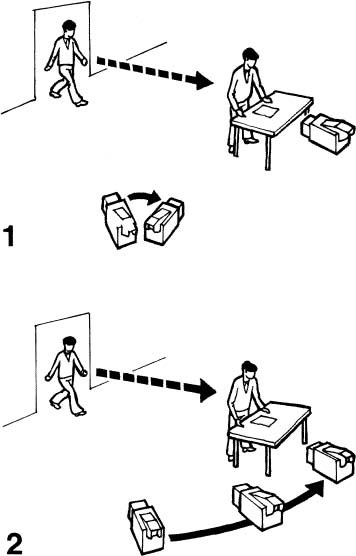‘Dolly’ is the general term for any wheeled camera mounting. As this camera mounting moves to and from the subject, we dolly in (track in) or dolly out (track out).
The dolly wheels can be steered in a straight tracking line, a curved track, or in an arc round the subject. As we saw earlier, pedestals can have two modes – dolly and crab. Where camera moves or camera positions are critical, you may find it helpful to draw discrete guide marks on the floor in removable chalk or crayon at strategic points.
Unlike the action of zooming, which simply expands and contracts the same image, dolly shots take us within the scene, passing various objects as we travel. We see the interaction of planes as the camera passes them, creating a strong illusion of depth and space.
Having focused the lens at a particular distance, you will naturally have to readjust it as you dolly nearer and further from the subject. How critical focus readjustment is, depends on the depth of field available. (That you remember, relates to the lens’ focal length and aperture and changes progressively with distance.)
The focus control rotates in one direction to focus away from the camera (focusing back), and the other direction to focus towards it (focusing forwards). How easily you can adjust the focus control while dollying, depends on its design and the amount of compensation needed to maintain focus. Some camera operators make continuous adjustments while moving; others refocus gently as the main subject in the viewfinder picture starts to ‘go soft’ (for a high-definition viewfinder should reveal unsharpness long before it is apparent on a TV receiver).
The floor of a TV studio is normally specially laid to provide a flat, smooth surface, over which cameras can dolly freely in all directions without risk of picture bounce. On location, where floor irregularities can cause problems, a camera may have to remain at a fixed viewpoint and rely on zooming to simulate dollying (moving to new positions while off-shot). Otherwise special lightweight dollies fitted with pneumatic tires (instead of the usual solid-tired wheels) are used for limited movement. Occasionally, special floor rails may be necessary, which allow the camera dolly to move smoothly over uneven ground.
Fixed and moving viewpoints
When the camera pans around from a fixed position, the audience turn their heads to follow the action. The director may then cut to a new viewpoint to watch its continuation.
When the camera moves around, it changes the audience’s viewpoint, ‘walking them over’ to the new position in a smooth continuous movement.

